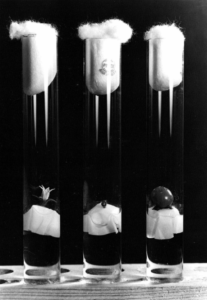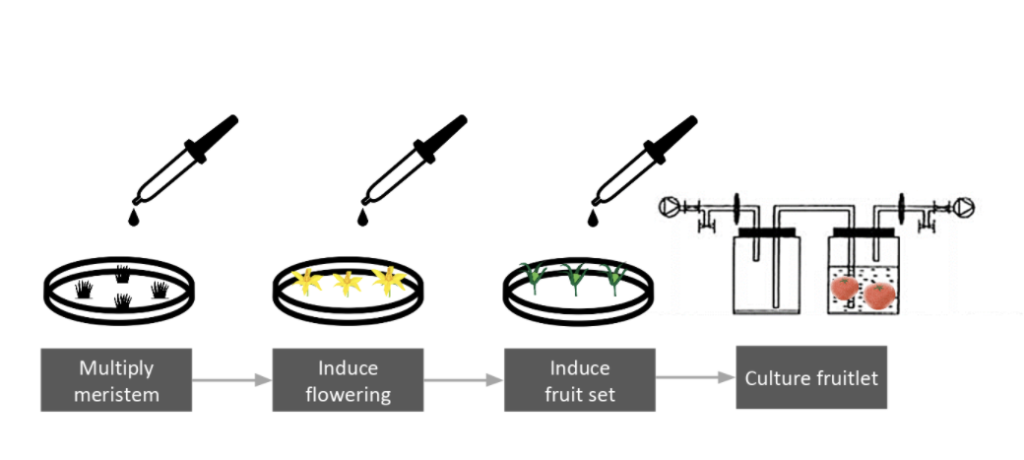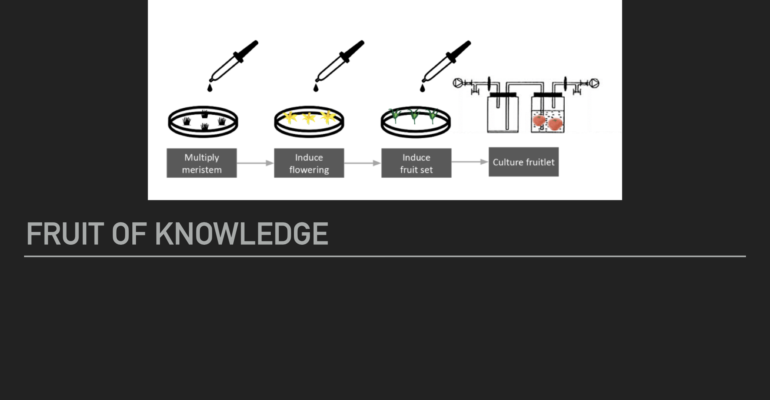Eliminating Light Requirements in Modern Agriculture
Currently, one of the greatest barriers faced by vertical farmers is the huge electricity demand, to which the artificial lighting requirements are a major contributing factor. Innovators are working hard to solve this problem and exploring possible solutions that implement scientific and technical knowledge from a range of disciplines.
The AVF spoke to Lucas van der Zee, who is working on ‘Fruit of Knowledge’, a research project which undoubtedly pushes the boundaries of agricultural science in numerous novel ways. They will research a technology that has many of the same advantages of vertical farming, such as no pesticide use and reduced water and nutrient requirements; but, curiously, it may not require light at any point of the process.
“It stretches what you think is possible, so we think that there will be loads of interesting spin-offs.”
By-Passing Photosynthesis Using Sugar:
In his pioneering research in 1951, J.P. Nitsch excised a flower from a tomato and grew it on a medium of sugars and nutrients until a fully developed tomato fruit emerged:

Nitsch, J. P. (1951). The role of plant hormones in fruit development (Doctoral dissertation, California Institute of Technology).
‘Fruit of Knowledge’ is working on “radically innovative food production technology for producing only the harvestable organs instead of the whole plant.” It uses a carbohydrate/sugar source to fuel the plant directly instead of using a light source, which would normally drive photosynthesis to produce the carbohydrates/sugar required for growth. This completely eliminates the light source requirement from the process.
“The thought is that instead of letting light produce that sugar, you could have a site somewhere in the world [with] good environmental conditions where you produce the sugars […] You have to produce a sustainable source of sugars and then transport them to areas where fresh fruit/plant production is hard.”
The sugar used is simply table sugar, specifically sucrose. Therefore, the sugar can come from sugar beet or cane sugar, but Lucas suggests that it could also be “[…] a recycled form of sugar [from] food waste that you hydrolyze to create the sugars.”
The process will also implement new breakthrough technology to induce flowering “…instantaneously instead of letting a whole plant grow” and without genetic modification, which has clear advantages with regards to consumer acceptance.
“We have this transdisciplinary design process, which basically involves [having] conversations with people from industry and we really want to involve the AVF network. So vertical farmers, but also people in the tissue culture industry, chefs/restaurants, and consumers.”
The aim is to clearly define what the requirements are for a successful product using this technology, with the intention of reaching out to the vertical farming community for input during the design process:
“We really want to know how this technology could work for vertical farmers […] and get some input on that.”
The idea for the Fruit of Knowledge research project took root at Wageningen University, where Lucas initially investigated the feasibility of this novel type of ‘lab-grown fruit’ agriculture.
“I saw that all the different steps of the process had basically been tried out in science, but nobody has really put together the whole process and researched it. There are still some bottlenecks in terms of efficiency of the process, but there are solutions to those […] we want to set up a 4-year research project to see if we can produce fruit without a plant.”
The project is now a collaborative effort between the Horticulture and Product Physiology (HPP) group at Wageningen University; the Laboratory of Biochemistry at Wageningen University; and the Plants and Cropping Systems in Horticulture (PSH) research unit at INRAE.
“The hard part about it is, on the one hand, some of the science is on the fundamental level – especially inducing [flowering]. On the other hand, it’s really applied. So, our main challenge right now is to find the right source of funding that is sort of between these two levels: both applied but also more fundamental science.”
The 4 Steps of Lab-Grown Fruit Production:
Part 1: Multiplication stage
Firstly, a source of stem cells is required. These are then multiplied. For lab-grown fruit, the stem cells come from the meristem in the plant shoot tip.
“This is basically something we have to optimize a little bit and make sure that we get a good system going because, once we have lots of meristem, then we can do all our experiments with that.”
Part 2: “The big fundamental question: how do we induce flowering in those meristems?”
“We’ve found what we really think is a breakthrough technology by inducing those flowers without making use of genetic modification.”
Part 3: Inducing fruit production
Once a flower has been pollinated there are specific compounds produced in the plant that cause the fruit to start growing. Instead of pollination, it is possible to directly apply these compounds and induce the fruit step. This has already been quite well researched so will not be the main focus of the project.
Part 4: Growing the fruit
This involves providing optimal nutrients and carbohydrates. Fruit of Knowledge also proposes to innovate bioreactors for growing the fruit.
“So, our two main areas of focus are the induction of the flower with this novel technology and also the modeling and experimentation with the fruit growth”

Image credit: Lucas van der Zee
Future Scope, Commercialisation and Spin-Off Applications:
Fruit of Knowledge intends to dedicate the first two years of research to solve some fundamental issues. After four years, they want to present both proof of concept as well as some conceptual designs to show how this technology could be implemented, working with stakeholders to see how this can be turned into a commercial reality. This will also involve optimizing some quality attributes, including taste, as well as scaling up, working on the efficiency of the system, and understanding consumer acceptance.
For now, the research is being carried out using tomatoes as a model fruit, but Lucas is positive about the possibility of expanding to other produce in the future:
“I expect there is some translation that will be needed but lots of the fundamentals will be the same.”
Lucas is also excited about the potential spin-off applications, including the “myriad” of great applications that could stem from the ability to control flowering or induce fast flowering.
“Maybe you want more control over your supply-demand and flowering, or maybe you want to flower a lot earlier or do really fast-breeding, those kinds of things […] if we have this high-precision control system for growing a fruit then there are lots of insights we can get. For example, relationships between the influx of nutrients and sugars and the final fruit quality.”
Author: Laura Nelson



Comments are closed.